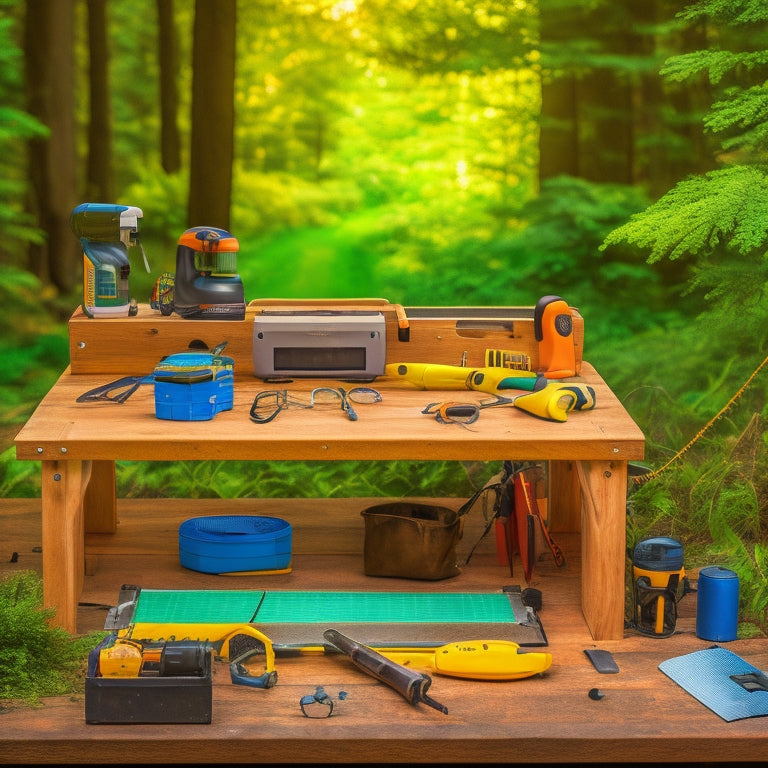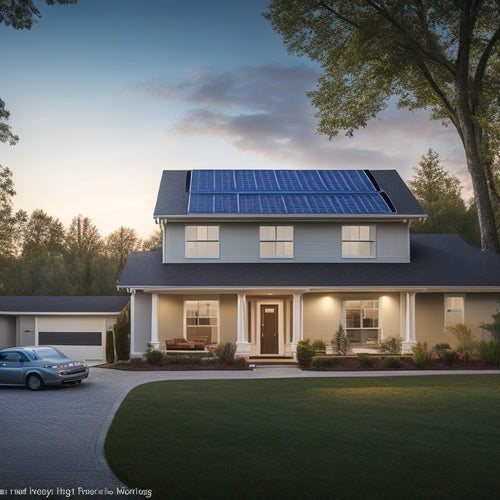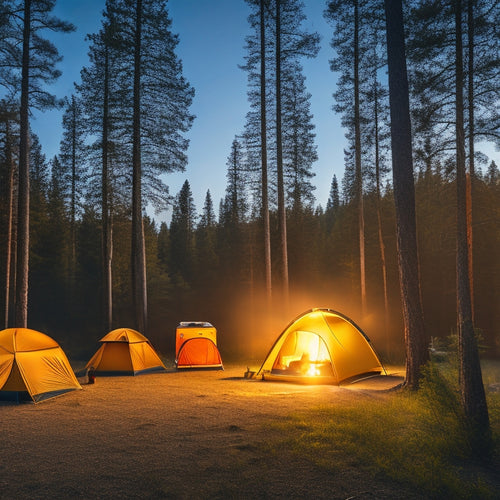
What's in a DIY Off-Grid Energy Kit?
Share
You're investing in a DIY off-grid energy kit to power your home or cabin with renewable energy, and selecting the right components is vital for a reliable and efficient system. A typical kit includes essential components like solar panels, a charge controller, inverter, and mounting system to convert sunlight into electricity. You'll also need energy storage solutions like deep-cycle batteries or lithium-ion batteries to guarantee a steady power supply. Additionally, a monitoring and control unit helps track energy efficiency in real-time, allowing you to optimize system performance. With the right kit, you'll be well on your way to achieving energy independence - now, it's time to get into the details that'll make your system truly thrive.
Overview
- A DIY off-grid energy kit typically includes solar panels, a charge controller, inverter, mounting system, and wiring for efficient energy conversion.
- Essential components work together to provide reliable, eco-friendly energy solutions, ensuring a steady power supply during low generation periods.
- Energy storage solutions, such as deep-cycle or lithium-ion batteries, are crucial for storing excess energy generated during the day for later use.
- Mounting and wiring systems, including durable hardware and proper wiring protocols, are necessary for secure and efficient installation.
- Monitoring and control units enable real-time tracking of system energy efficiency, allowing for remote monitoring and optimization of system performance.
Understanding Solar Panel Kits
When venturing into the world of off-grid energy, solar panel kits are an indispensable element to consider.
You're likely drawn to the numerous solar energy benefits, including reduced carbon footprint, lower energy bills, and increased energy independence.
As you consider choosing solar kits, it's vital to understand the importance of selecting a high-quality kit that meets your specific energy needs, bearing in mind Key Considerations for DIY Solar Systems such as high-efficiency panels and durable mounting systems.
You'll want to assess factors such as your energy consumption, available roof space, and local building codes.
By doing so, you'll be able to choose a solar panel kit that effectively utilizes the power of the sun, providing you with a reliable source of off-grid energy.
With the right kit, you'll be well on your way to achieving energy freedom.
Essential Components Inside
Your DIY off-grid energy kit will typically include several essential components that work together to capture and convert sunlight into usable electricity.
These components are designed to optimize energy efficiency and promote sustainability practices. Many kits, such as the Eco-Worthy and WindyNation, offer pre-wired and pre-assembled components to simplify installation, minimizing errors and setup time easy installation.
You'll find a charge controller, which regulates the flow of energy from the solar panels to your storage system, preventing overcharging and ensuring safe operation.
An inverter is also included, converting DC power from the solar panels to AC power for your home or device.
Additionally, a mounting system and wiring system enable secure and efficient installation.
These components work in harmony to provide a reliable and eco-friendly energy solution, enabling you to take control of your energy needs and live off the grid.
Off-Grid Energy Storage Solutions
Now that you have a reliable source of off-grid energy, it's time to think about storing it efficiently.
You'll need a suitable energy storage solution to guarantee a steady power supply when the sun isn't shining or the wind isn't blowing. This is where advanced battery technologies come in.
Look for deep-cycle batteries designed specifically for off-grid systems, which can handle frequent charge and discharge cycles. Consider lithium-ion batteries, known for their high energy efficiency and long lifespan.
When selecting a battery, research top-rated solar battery brands such as Tesla, LG, SimpliPhi for reliability and durability.
A well-designed energy storage system will maximize your energy harvest, minimize waste, and provide a reliable backup during power outages.
Mounting and Wiring Systems
Three key components come together to form a reliable off-grid energy kit: a power generation source, energy storage, and a mounting and wiring system that connects and secures everything.
When it comes to your mounting and wiring system, you'll need to choose the right mounting techniques to guarantee your equipment is safely and securely fastened. This might include using durable hardware, like stainless steel or anodized aluminum, and selecting the right type of mounting structure, such as a roof-mounted or ground-mounted system.
You'll also need to prioritize wiring safety by following proper wiring protocols, using the correct gauge wire, and protecting your wiring from environmental elements.
Monitoring and Control Units
How will you guarantee that your off-grid energy kit is operating at peak performance? You'll need a monitoring and control unit to track your system's energy efficiency in real-time.
This unit allows you to monitor your energy production, consumption, and storage levels remotely, ensuring you're maximizing your energy output. With remote monitoring, you can identify areas for improvement, optimize your system, and prevent potential issues.
A monitoring and control unit typically includes features like data logging, alarm systems, and automated alerts. This enables you to take corrective action quickly, ensuring your off-grid energy kit operates at its best.
Frequently Asked Questions
Can I Install a DIY Off-Grid Energy Kit Myself Without an Electrician?
You can install a DIY off-grid energy kit yourself, but be aware of installation challenges and prioritize safety considerations, making certain you follow manufacturer instructions and local electrical codes to avoid hazards and guarantee a reliable, independent power supply.
Are DIY Off-Grid Energy Kits Compatible With All Types of Roofs?
You'll find that DIY off-grid energy kits are compatible with most roof types, but you'll need to check the installation requirements for your specific roof, as some may require additional mounting hardware or adjustments for ideal performance.
How Long Does It Take to Assemble and Install a DIY Energy Kit?
You'll be energized to know that 70% of DIY off-grid energy kit owners complete assembly in under 10 hours. Following installation tips, you'll spend around 2-5 hours on assembly time, and then enjoy the freedom of utilizing renewable energy.
Can I Expand My DIY Off-Grid Energy Kit in the Future if Needed?
You can easily scale up your off-grid energy system for future upgrades, ensuring energy scalability that adapts to your growing needs - simply add more panels, batteries, or inverters to increase your power output as required.
Are DIY Off-Grid Energy Kits Eligible for Government Rebates and Incentives?
You're likely eligible for government rebates and incentives with your DIY off-grid energy kit, like the Californian who received a $10,000 rebate through the California Solar Initiative; check federal and state incentive programs for rebate eligibility.
Ready to Buy
As you piece together your DIY off-grid energy kit, the puzzle comes alive, illuminating your path to independence. With each component in harmony, your system hums like an orchestra, generating power that's as free as the sun. Now, you're the conductor, orchestrating your own energy destiny, untethered from the grid.
Related Posts
-

Is This the Future of Alternative Energy Systems
Yes, alternative energy systems are shaping the future of energy. Innovations in solar and wind technologies are driv...
-

Cost of Solar With Battery Backup
You're investing in a solar panel system with battery backup to guarantee reliable power during outages. The cost of ...
-

Top Solar Powered Camping Fans for Camping Enthusiasts
If you're a camping enthusiast, a solar-powered fan can be a transformative element for your outdoor experience. Thes...


